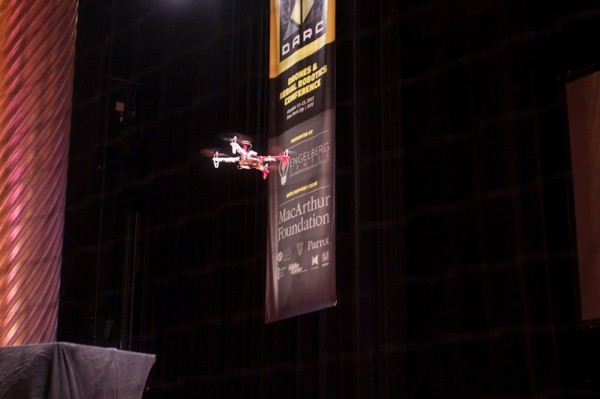
Photo Credit: Hannah Gais
From botched attacks to UAV landings to Jeff Bezos’ fleet, drones have made headlines in 2013. Here are some of the most important 2013 events in the UAV world.
X-47B carrier landing
The X-47B, Northrop Grumman’s unmanned aerial combat vehicle (UCAV) designed for carrier-based operations, made headlines earlier this year as it became the first unmanned vehicle to autonomously land on an aircraft carrier. With no guidance from an experience navel aviator, the X-47B made its first arrested landing on the USS George H.W. Bush on July 10, 2013. The first drone launch from a carrier came a few months earlier in May 2013.
Carrier operations are tough enough for human operators, let alone robots. Nevertheless, drones have again proven themselves capable of going above and beyond, and the Navy hopes to apply the technology that made such a feat possible to the rest of the U.S. drone fleet. It hopes carrier-ready drones will be usable within the next three to six years.
Obama’s “revamped” drone policy
On May 23, 2013, U.S. President Barack Obama laid out his administration’s “revamped” counterterrorism policy in a speech at National Defense University. In addition to promising to take new steps to close Guantanamo Bay prison and generally shifting the U.S. away from a “boundless global war on terror,” the president proposed to narrow the scope of the controversial targeted-killing campaign against terrorist operatives. Obama’s primary point is that:
Our systematic effort to dismantle terrorist organizations must continue. But this war, like all wars, must end. That’s what history advises. That’s what our democracy demands.
Despite pleas for more transparency, the ramifications of Obama’s policies are, as the New York Times noted after the speech, somewhat unclear as many of these policies remain classified. For those of us not blessed with a security clearance, discerning any significant change from pre-May 2013 drone policy to post-May 2013 drone policy can be difficult, if not impossible. Regardless, Obama’s address is at least of symbolic significance.
U.S. Congress hears from drone victims for the first time
Despite assurances from the White House that strikes only take place when there is “near certainty” that no civilians are in danger, dual reports from Amnesty International and Human Rights Watch (HRW) have indicated there have been more civilian deaths than the U.S. is willing to admit. For those living in regions where these strikes are common, little is known about the negative effects, including but not limited to loss of life, of drones.
Thus, Rep. Alan Grayson (D-FL) organized a hearing in October to provide Congress with live testimony from victims of drone strikes. Rafiq ur Rehman, a schoolteacher in Pakistan, and his son and daughter testified on the death of their mother. Congress was notably absent; only five Congresspeople were in attendance.
FAA tackles drone policy (finally)
In a dramatic shift from its “do nothing, say nothing” approach to drone use, the Federal Aviation Administration announced on December 30, 2013, that it has designated six test sites for unmanned aerial systems research. These six sites, notes the FAA, “will conduct critical research into the certification and operational requirements necessary to safely integrate UAS into the national airspace over the next several years.” The six sites and their respective areas of focus are as follows:
The FAA’s current outline draws upon its first annual “roadmap,” released on November 7, addressing the policies and procedures needed to safely integrate UAVs into domestic airspace. Which brings us to…
Expanded commercial use
Charlie Rose: Oh, man…Oh, my God!
Jeff Bezos: This…
Charlie Rose: This is?
Jeff Bezos:…is…these are octocopters.
Charlie Rose: Yeah?
Jeff Bezos: These are effectively drones but there’s no reason that they can’t be used as delivery vehicles. Take a look up here so I can show you how it works.
In a “60 Minutes” segment aired on December 1, Jeff Bezos, the founder and CEO of Amazon.com, announced it was testing fully autonomous delivery drones capable of carrying up to five pounds of goods. At the earliest, these drones could be in use by 2015—the year the FAA is due to open up domestic airspace to commercial drones. Enthusiasts exploded with the news. After all, what’s better than a drone—yes, you can order drones on Amazon—being delivered in 30-minutes by a drone?
But drones have been making waves in the commercial world already. Indeed, the FAA issued the first commercial license to ConocoPhillips, an oil company, to use a ScanEagle, the same type of unmanned vehicle captured by the Iranians in 2012. Meanwhile, Rolls-Royce is producing drone engines and promises a future with drone ships. And drones may also be due to invade agriculture if one company has its way.